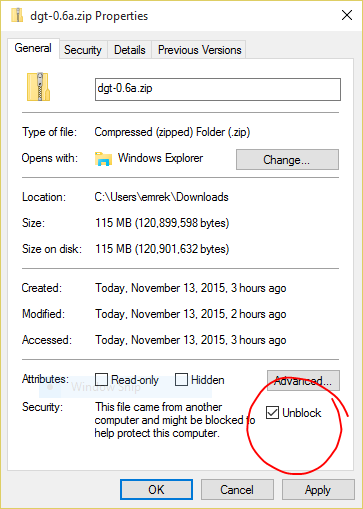Installing the Discussion Graph tool
This short step-by-step walks you through installing DGT and adding it to your execution path.
-
To install the Discussion Graph Tool, Download the latest DGT release as a zip file.
- Install the prerequisite .Net Framework 4.5
-
Check that the downloaded DGT zip file is “unblocked” on your computer. Right-click on the downloaded zip file, and click “properties…” and ensure that the “Unblock” check box is checked and click Apply, or press the “Unblock” button in older versions of Windows.

- Extract the dgt-0.5.zip file to a location, such as your user directory c:usersmyName (where myName is your login), c:program files, or an alternate location, such as e: Wherever you decide to extract the zip file, you should find a dgt directory, and within it a bin directory
- Edit the system environment variables to add the dgt-0.5bin directory to the execution path.
- To do so, open the Control Panel, search for Environment Variables and click “Edit the System Environment Variables”.
- In the Advanced tab, click the environment variables button
- Select the PATH variable from the system variables list and click the Edit button.
- Edit the variable value (the current search paths), and append a ‘;’ (semicolon character without the quotes) and the full path to the DGT binaries. (don’t forget to include the trailing dgtbin directory, e.g., c:usersmyNamedgtbin, c:program filesdgtbin or e:dgtbin).
- Click OK.
- Test the installation
- Open a new command-line window (run cmd.exe)
- Type the command “dgt”. You should see the following output.
>dgt –helpDiscussion Graph Tool Version 0.5More info: https://www.microsoft.com/en-us/research/project/discussion-graph-tool/Contact: discussiongraph@microsoft.comUsage: dgt.exe filename.dgt [options]Options:–target=local|… Specify target execution environment.–config=filename.xml Specify non-default configuration fileTo learn more about the Discussion Graph Tool, read the getting started guide and the step-by-step walkthroughs.
